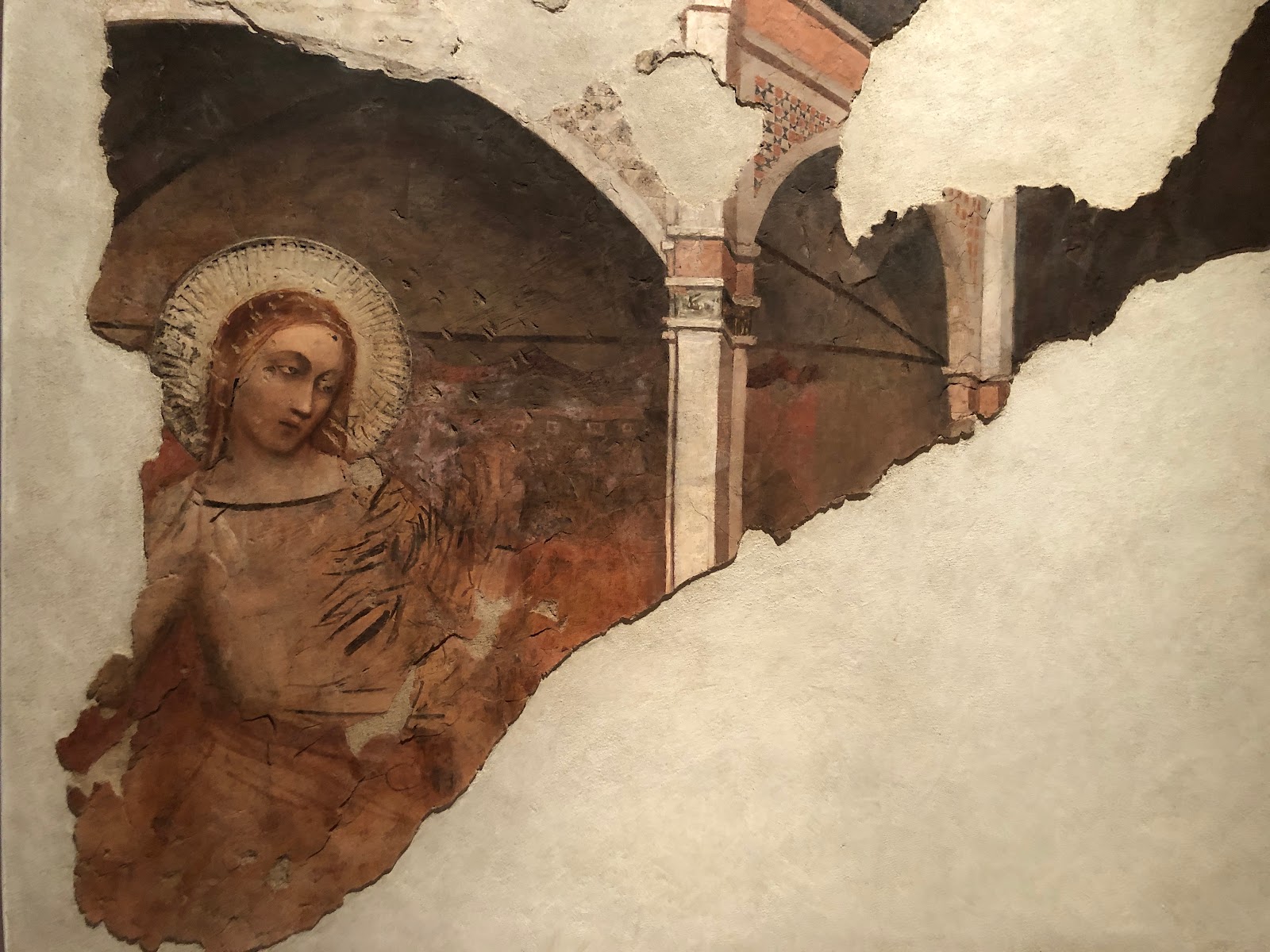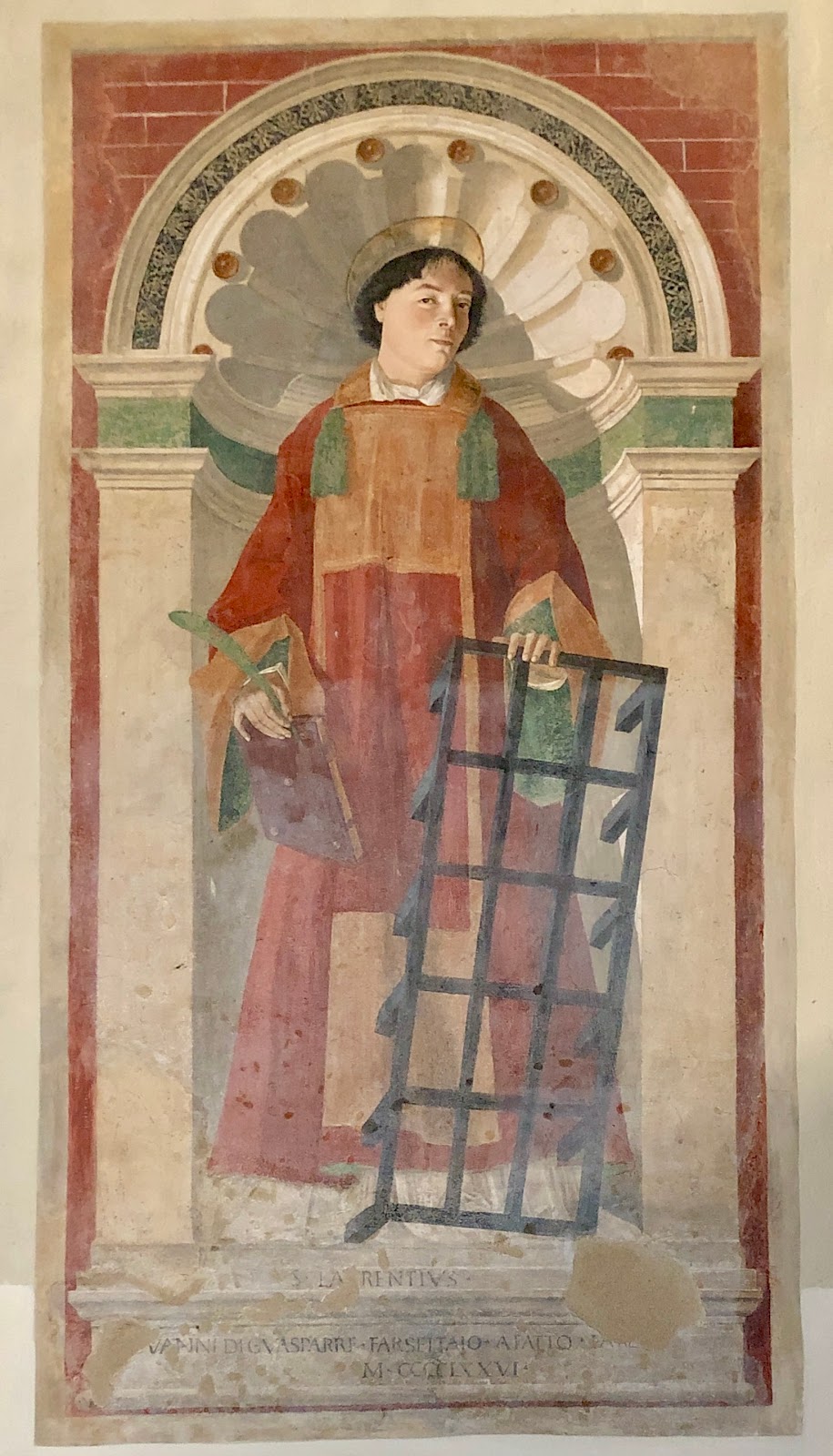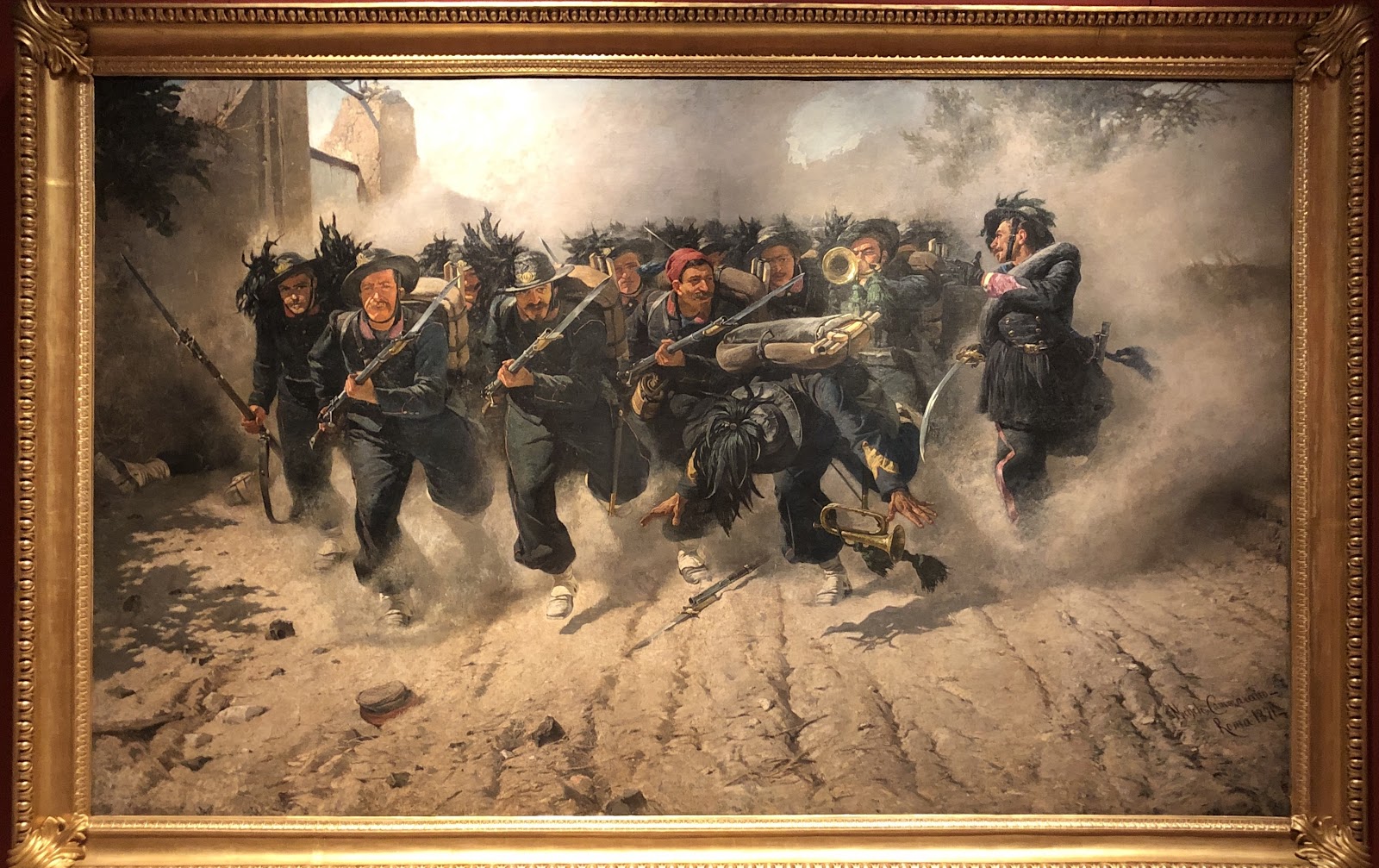In this article I aim to 'keep it short' by combining brief comments on several works of art seen in Italy recently. Let's see if that's possible!
I'll start with a supposed Giotto discovered - so far as I am concerned - in the Pinacoteca Comunale, a small museum run by the city of Assisi.
Pinacoteca Comunale, Assisi (Photo: the author)
This image is included because my last article was concerned with Giotto's construction of buildings and here we have a very highly developed example. The entire kiosk or tabernacle in which the figures are placed is extremely convincing in terms of its representation of space; the planes of the throne, the walls and the ribbed ceiling all function without any disharmony between the parts. In other words, the perspective looks right! As well, the external surfaces of the tabernacle, decorated with cosmatesque inlay, all conform to the interior space; frequently in this period, the exterior surfaces of a structure do not wholly conform to the 'inside' parts. Here on the other hand, we have clear evidence of the comprehension of how we really see things (or, how things really look). In fact, from that point of view, the figures - sadly much damaged - are the weak part of this painting.
***
Next is another detached fresco in the same museum: this one is by a slightly later artist called Puccio Capanna (notices from 1341 to 1347), or Pace di Bartolo. The attribution is uncertain as the label beside this work in the Pinacoteca Comunale clearly states that the author is Puccio whereas other sources give it to Pace!
The Annunciation by Puccio Capanna (or Pace di Bartolo), detail of a fresco fragment
Pinacoteca Comunale, Assisi (Photo: the author)
To me, this is a very beautiful image albeit much afflicted! It appears to be a sinopia, the drawing under the finished fresco, a sepia-coloured painted line-drawing, normally fairly well-developed, made by the painter on the rough plaster before the finer top layer is applied, and which functions as a guide for the finished, coloured stratum. These preliminary 'drawings' are only visible when a finished fresco - that is, the final paint layer - is detached from a wall, thus revealing the initial stage on the plaster beneath. In the photo we can also see the results of the hammer or pick blows made by later artisans; when times and tastes changed, it was not uncommon for older, out-of-fashion pictures to be chipped away at, as in this example, so as to give some purchase for a new layer of plaster, for a new painting! When again tastes changed and that later image was removed, often there are the traces of the earlier, original fresco and that is what I think we see here. Also very interesting are the 'test' strokes - something I have not seen elsewhere -, the clearly nonchalant brush marks across the right side of our figure; who made those strokes, the original artist, knowing that they would be concealed by his top layer of plaster (very unlikely), or some later artisan as he prepared for a new work? In addition we might notice the raised halo surrounding the Virgin's head: this was also done in plaster and, in the finished piece, would have been decorated in gold leaf - now long gone of course.
The Annunciation by Puccio Capanna (or Pace di Bartolo), entire fresco fragment
Pinacoteca Comunale, Assisi (Photo: the author)
Although I am discussing this image as if it were a sinopia, there is something very unusual about the other part of what remains of this fresco (the 'room', above) in that it seems to be finished, that is, it has the top layer of paint: a combination within the self-same 'relic' of two distinct stages of work - part sinopia and part final layer! This layer of colour is obvious on the right exterior 'wall' and the columns of the structure in which the Virgin is placed; interestingly, there are no hammer marks in those parts. In the vicinity of the Virgin, to the right of her halo, there are traces of coloured paint, and in the arch above her, the cosmatesque decoration has also suffered in some way. In my experience, the co-existence in the one image of two stages of the process of fresco painting is extremely rare.
***
Now we've moved to Arezzo and in a church there, on the inside of the façade wall, is this next work, a fresco by an artist known as Bartolomeo della Gatta (1448 - 1502).
San Lorenzo by Bartolomeo della Gatta , 1476, fresco
The Church of the Badia, Arezzo (Photo: the author)
This particular work is another instance of a fresco having been rediscovered: in this case in 1933 by the canon priest who, having read Giorgio Vasari's Life of Bartolomeo 1, began scraping away the covering plaster in the area he believed Vasari had mentioned as the site of this Saint Lawrence. The lower part has suffered quite a lot but the upper part is still in excellent condition. But what is particularly remarkable is the painting of the face of this saint or, to be more precise, this exquisite portrait! It was in fact the representation of this face which stopped me in my tracks as I was on my way out of the church: its 'modernity' is extraordinary. Its quality of life-likeness, its being clearly a portrait, its consummate treatment of light and shadow, the off-centre turned head, the questioning gaze of the sitter, all are wholly remarkable ... and this in 1476, not 1976!
Bartolomeo is interesting in other ways as well: in addition to being a painter, he was also an architect, a musician, a designer of organs, a manuscript illuminator and ... a monk. As it happens, quite a few of the most notable artists of the Renaissance were members of the clergy in one way or another. Bartolomeo, whose real name was Piero di Antonio Dei, had joined a monastery in Florence while still very young and eventually became the abbot of two of them in Arezzo. Below is another example of his work.
Museo Diocesano, Arezzo (Photo: the author)
The work shown above is a very large detached fresco (with parts missing from all sides) under which was found the quite simple sinopia drawing (kept in the same museum). Apart from the figure of the saint - recognisable from his 'attributes': the lion, the cardinal's red hat (although Jerome was never a cardinal) and the Crucifix - the obvious other 'star' of this wonderful image is the extraordinary representation of the rocks, realistically indicating Jerome's hermit desert retreat. In spite of being a Renaissance painting, the artist has continued the more traditional practice of including several smaller scenes from the saint's life, across the top right corner.
***
Still in Arezzo and still in the Badia church, let's look at an enormous altar-piece painted by the author of the Lives - and the architect of the Uffizi in Florence - Giorgio Vasari (1511 - 1574) 1. Vasari was born in Arezzo and was a painter, an architect and, perhaps most famously, an art historian; in fact, he is recognised as the first modern historian of art. Many of the people he wrote about are, as artists, far more famous than he, however, his literary magnum opus, the Lives, despite being constantly criticised, is still a basic text for anyone studying Western art history.
The Church of the Badia, Arezzo (Photo: the author)
This recently restored altar-piece is very large, five metres high and four metres wide, and has, as well as its central theme, two largish panels both showing a standing saint, one on either side, as well as eight smaller panels surrounding the arch of the principal image. The figures in the lower part display the surprise and wonder of the Apostles as they witness the ascension of Mary's body into heaven and I think it is that kind of rhetorical gesture and pose which is disapproved of by many historians; the upper half on the other hand, exemplifies what I consider to be Giorgio's strengths.
Detail of the previous photo showing the Coronation of the Virgin (Giorgio Vasari)
As said, this painting is enormous and so it was difficult to get a good photo of the top portion, nevertheless, to my mind, there is almost a net difference between the upper and the lower portions of this double image. As with many of Vasari's paintings, this one too is influenced by Michelangelo's Sistine Ceiling work, notably the Creation scenes, a kind of amalgamation of the Creation of the Planets and the Creation of Adam. Vasari has here adjusted the pose of Michelangelo's great figure of God the Creator - note the positions of the arms and legs 2 - while also keeping the accompanying angels. Mary's hand movement, directed towards Christ the King, is reminiscent of the gesture of Adam as he languorously reaches towards God, his creator. However, the influence or not of Michelangelo (Vasari's art evolution 'hero') is not the main point; what I see here and in other similar works (for instance, his Immaculate Conception of 1540 in the church of Santi Apostoli in Florence) is Vasari's beautiful (Mannerist) Madonna, the wonderful way the clothes cover the forms and at the same time reveal them, the gentleness of his imaginings of the Mother and Son (see for example, also in the Badia, above the main altar, the beautiful figure of Christ as he converses by the lake with the fishermen Apostles).
***
Now something a little different, an example of Baroque architecture: this is the inside of the dome of a not-large circular - or, more precisely, octagonal - church in the historical centre of Naples. I was initially attracted into this little gem by the advertisement of the existence within of a painting by Caravaggio! On entering the small building, two things strike the unprepared visitor: first, the awe-inducing Caravaggio canvas facing you as you enter; I could have said silence-inducing as no-one speaks while studying this magnificently obvious masterwork, The Seven Works of Mercy (1606-07). The other striking thing is that, like a number of Baroque churches, it is polygonal in plan (as opposed to basilican) and as well, on looking up, one sees the dome pictured here.
I have included this photo because I was struck (third strike!) by the simple, almost modernist restraint and the elegant refinement of the design (and the colour) - quite different from many of the domes in both Naples and Rome, lovely as they are. Note the clear blue visible through the lantern (a sort of raised mini-temple set on the top of large domes to allow light to enter: see those on the cathedral of Florence and on St Peter's in Rome).
***
We'll finish these short stories with an altogether different type of image, this time what's known as a 'history painting'. This impressive picture by Michele Cammarano (born in Naples) is in essence an example of 'academic' painting, an official style sanctioned by art academies all over 19th century Europe (and even further afield). The basic idea was excellent draughtsmanship, especially of the human body (based on Renaissance models, in particular Raphael), skilled colouring and historical accuracy; there was a type of hierarchy in which 'history painting' - the depiction of historical and mythological subjects - was at the top, and the closer to known facts of costume, arms and armour, setting and so on the artist could come, the better the work. That said, Cammarano's affinity with a native Florentine school known as the Macchiaioli, which he encountered while briefly in Florence, is also important.
This again is a very large painting (nearly 6 by 4.5 metres) and, although showing signs of academicism is enlivened with certain traits of the Macchiaioli 3. Importantly and oddly, the image looks like a 'still' from a movie, a technology which didn't exist at the time (1871); today we could easily imagine the 'shooting' (no pun intended) of such a scene, with a movie camera mounted on tracks and being pulled backwards as the actors rush towards it.
The Bersaglieri are one of the oldest regiments in the present Italian army and are famous for their plumed hats and their ability to run while playing bugles! In the painting above, they are shown charging - and dying - as they attack one of the gates of Rome (Porta Pia) during the final battles for Italian unification. The artist had himself served in the armed forces, an experience which had a decisive influence on his art. As mentioned, this work is also very large and, 'in person', as might be imagined, has a powerful dramatic effect; its combination of highly skilful execution, historical accuracy (uniforms, weapons) and unusual and large composition results in a memorable if somewhat rhetorical image.
1 The Lives of the Most Excellent Painters, Sculptors and Architects, by Giorgio Vasari, published (in two editions in Florence, 1550 and) 1568.
2 In both of these amazing scenes, that is, God Creating the Planets and The Creation of Adam, the positions of God's arms and legs are very similar - not the same, but similar: in both, the arms are spread very wide although directed differently, and the legs (both of them in the Planets scene and the right one in the Adam scene) are bent. The different points of view explain the variations in position: in the Planets scene, God is represented somewhat foreshortened as He seems to come towards us whereas, in the Creation of Adam, God is shown as though we can see Him stretched out full-length.
3 The Macchiaioli were members of a 'school' of painting which developed in and around Florence in the mid-19th century. In some ways they resemble the Impressionists of France working at about the same time (for Australian readers interestingly, they have much in common with the local so-called Heidelberg School). Their interests were the normal, the everyday, the routine of life in a soon-to-be-gone world, the world of the near-by small-holding farmers, the fishermen on the banks of the Arno under the hot Tuscan sun, the interiors of the petit bourgeois. The name derives from the Italian word 'macchia' which can mean a bush, a mark or stain (as in caffè macchiato), but also a painting method consisting in the use of areas of broken colour applied as small dabs (macchie: that is, marks).









This comment has been removed by a blog administrator.
ReplyDelete